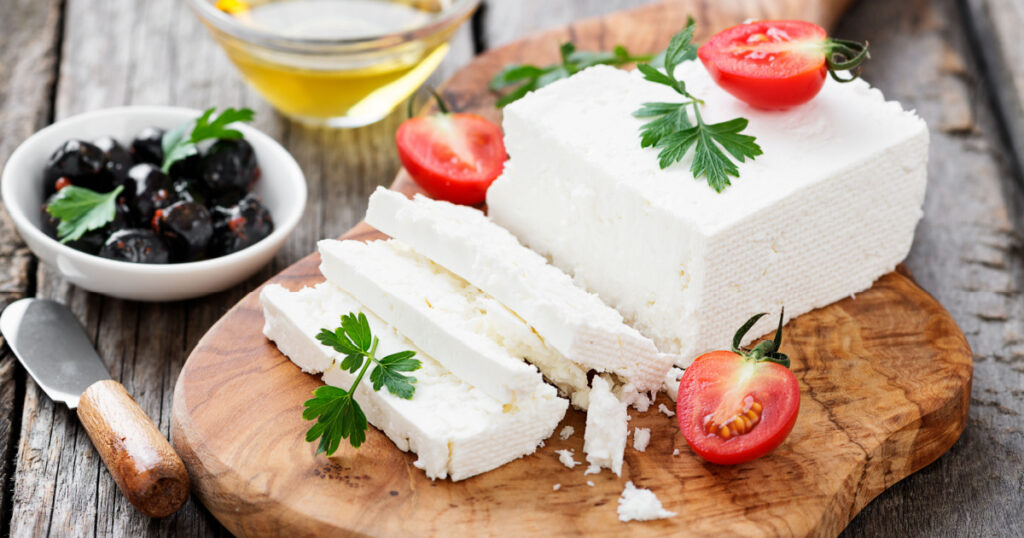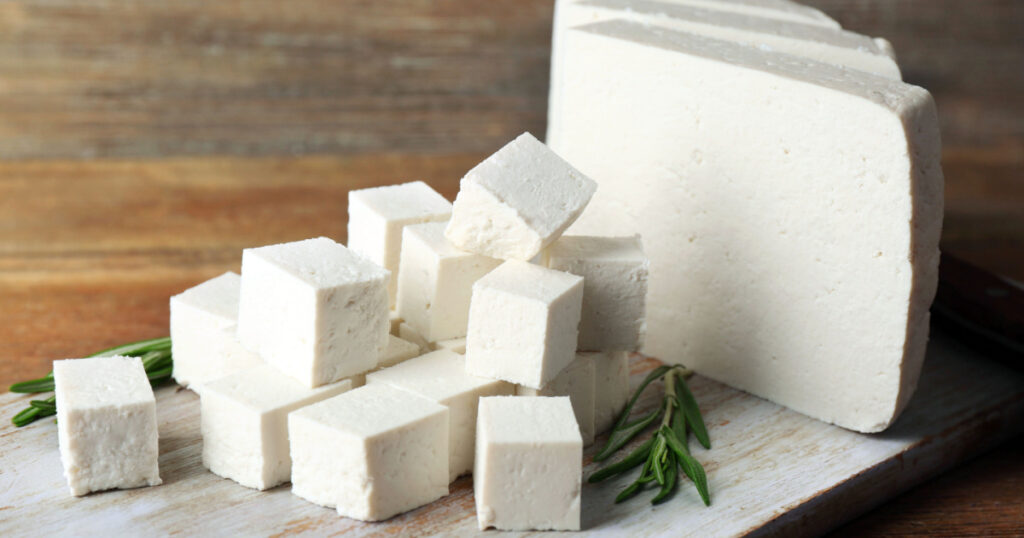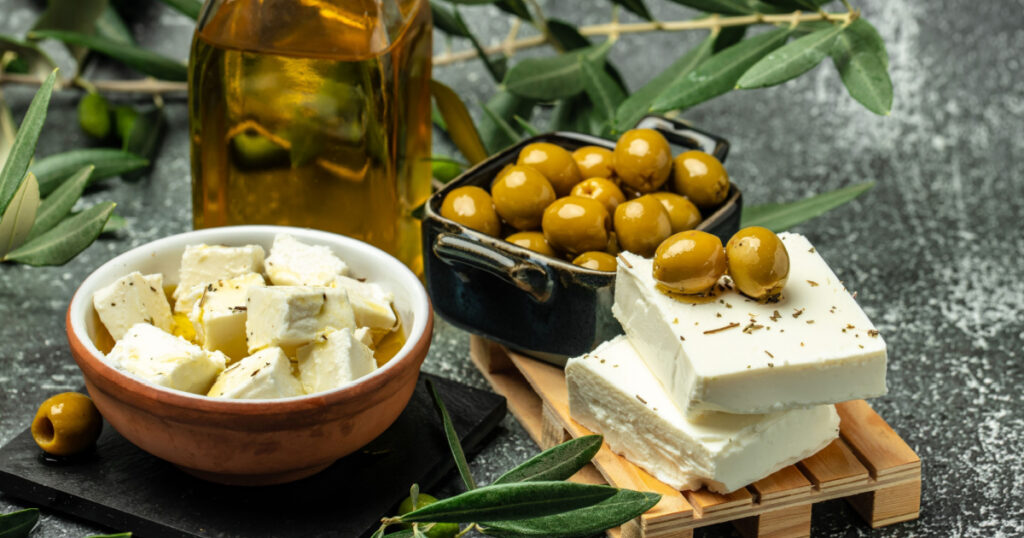[ad_1]
If you are a cheese lover, chances are you have had feta cheese. With its tangy flavor and crumbly texture, feta cheese has gained popularity worldwide and has become a staple ingredient in many beloved dishes. But what exactly is it, where does it come from, and how is it made? More importantly, does it have a place in a healthy diet? Let’s explore the origins of feta cheese, its different types, and, most importantly, the numerous benefits it offers.
What is Feta Cheese and its Origins?

Feta cheese is a type of white cheese that originated in Greece. It is traditionally made using either sheep’s milk or a combination of sheep’s and goat’s milk. The name “feta” itself comes from the Greek word “fetta,” which means slice. This cheese has been a part of Greek culinary history for centuries, and its unique taste and texture have delighted palates around the world. (1)
The crumbly cheese is a staple in Greek cuisine, but many people from other countries also enjoy it. The cheese has become increasingly popular throughout the world over the years and today feta can be found in supermarkets all over Europe, North America, and Australia.
The Making of Feta Cheese
The process of making feta cheese involves several steps. First, the milk is heated and then curdled using either rennet or an alternative such as lemon juice. The curds are then cut into smaller pieces and left to drain in special molds. After a few days, the cheese is removed from the molds and soaked in brine, which gives feta cheese its distinctive salty flavor. The cheese is then packed into containers and left to mature for several months. The longer it matures, the stronger its taste will become. (2)
Types of Feta Cheese
While traditional feta cheese is made using sheep’s milk, it is important to note that the feta you find in many stores in North America is often made with cow’s milk, sometimes with the addition of goat’s milk. The taste and texture of cow’s milk feta tend to be milder and creamier than the tangy and crumbly traditional sheep’s milk feta. However, both types have their own unique charms and can be used in a variety of dishes.
Read: People shocked after learning why Parmesan cheese isn’t vegetarian
The Benefits of Feta Cheese
If you’ve made it this far in this article, then chances are you are a cheese lover and, in particular, a fan of feta. Most of us, however, have probably never really thought of cheese as a health food. While sure, it may not be spinach, spirulina, or any of the other so-called “superfoods,” feta cheese actually does have some surprising health benefits.
1. Rich in Nutrients

Feta cheese is packed with essential nutrients, including protein, calcium, phosphorus, and B vitamins. It is also rich in vitamins A and K, folate, pantothenic acid, iron, and magnesium. These nutrients are crucial for supporting bone health, muscle function, and overall well-being. (3)
2. Good for Digestion

Feta cheese contains probiotics, which are beneficial bacteria that promote a healthy gut. Probiotics can help improve digestion, boost the immune system, and even enhance mood and mental health. (4)
3. Lower in Fat and Calories

Feta cheese is relatively low in fat and calories compared to many other cheeses. This makes it a wise choice for those looking to reduce their calorie intake without compromising on flavor.
4. Rich in Antioxidants

Feta cheese contains antioxidants like riboflavin and vitamin B12, which protect against aging, migraines, and fatigue. They also help to fight free radicals and reduce the risk of chronic diseases such as heart disease and cancer. (5)
Read: The Power of Natto, a Japanese Superfood
5. Excellent Source of Calcium

Feta cheese is an excellent calcium source, essential for maintaining strong bones and teeth. Adequate calcium intake can also help prevent osteoporosis and reduce the risk of fractures, particularly in older adults. (6)
6. Beneficial Fatty Acids

Conjugated linoleic acid (CLA) is a fatty acid found in animal products. CLA has been shown to reduce body fat, increase lean muscle mass, and improve insulin sensitivity. It may also help lower the risk of certain types of cancer. (7)
How to Buy Feta Cheese
When buying feta cheese, it is recommended to go for the freshest option available. Look for cheese that is white in color with a tangy aroma. Avoid cheese that appears brown or slimy, as this indicates spoilage. Feta cheese is available in blocks or crumbles, depending on your preference and recipe requirements.
Feta cheese is not only a delicious addition to many dishes, but it also offers numerous health benefits. From its nutritional value to its digestive benefits and versatility in recipes, feta cheese has rightfully earned its place in the culinary world. So, why not savor the tangy delight of feta cheese and experience its remarkable benefits for yourself?
Keep Reading: There’s Aluminum in Processed Cheese. Do you need to worry?
Sources
- “History of Feta.” Real Greek Feta
- “Is Fet a Goat Cheese?” Healthline. Cecilia Snyder, MS, RD. June 11, 2020.
- Self
- “Detection and Identification of Probiotic Lactobacillus plantarum Strains by Multiplex PCR Using RAPD-Derived Primers.” NCBI. Alex Galanis, et al. October 2015.
- “Feta Cheese: Good or Bad?” Medicine Net. Karthik Kumar, MBBS.
- “Dairy products, yogurts, and bone health” Pubmed. René Rizzoli. May 2014.
- “Conjugated Linoleic Acid: Potential Health Benefits as a Functional Food Ingredient.” Pubmed. Jun Ho Kim, et al. 2016.
[ad_2]
Source link
